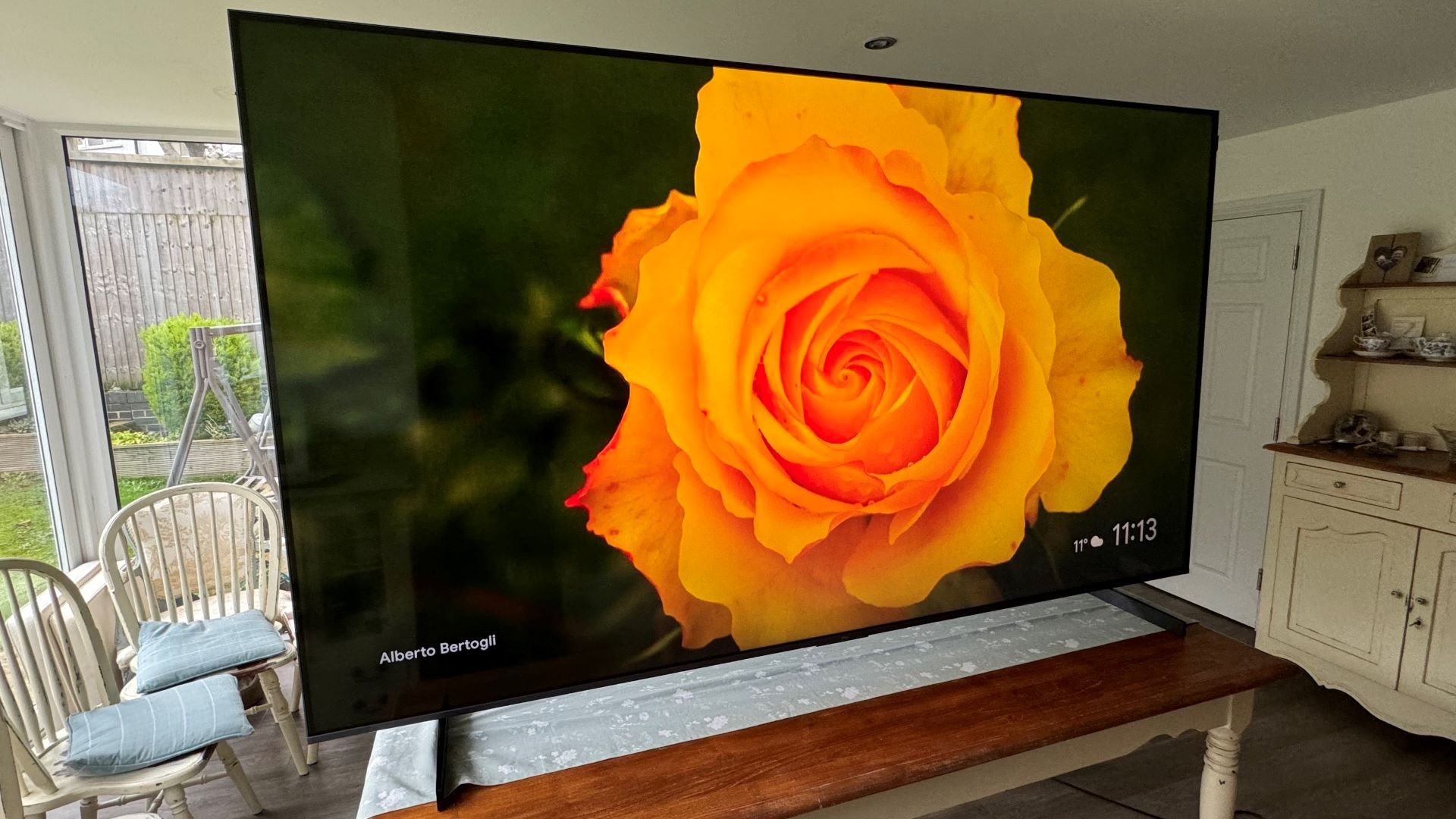
TCL 98Q9BK 98-inch TV: Two minute review
The TCL 98Q9BK is the latest part of TCL’s apparent bid to become the first brand you think of when you’re considering buying a really huge specimen of the best TVs. And true to form, it combines its vast 98-inch screen with a surprisingly unvast price tag.
The TCL 98Q9BK’s high-value proposition merely grows when you clock its spec sheet. Its epic screen is illuminated by mini-LEDs, backed up by a local dimming engine that can control light across a huge 1,536 separate zones. Peak brightness hits an enormous, high dynamic range-friendly 2,000 nits and more, while colour is delivered by a premium Quantum Dot system.
Smart TV features are provided by Google TV, and the TV can play all four of the main HDR formats. Gamers, meanwhile, can enjoy their hobby right up to 4K resolution and 144Hz frame rates, complete with variable refresh rate support.
The 98Q9BK proves massive fun to watch no matter what you’re playing into it. Its brightness is phenomenal, but thankfully this is backed up by impressive contrast courtesy of the impressive local dimming, while those QD colours go the extra mile necessary to keep saturations in line with the TV’s huge light output.
The 98Q9BK’s sound unexpectedly manages to be loud and large enough to actually match the scale of the TV’s massive pictures, too.
You need to take a little care with some of the TV’s settings to get the best out of it - especially given that there’s no hiding place for anything out of place on a 98-inch screen. Provided you’re willing to put in a little legwork, though, the 98Q9BK is a home cinema bargain par excellence.

TCL 98Q9BK 98-inch TV review: Price & release date
- Release date: fall 2024
- 98Q9BK: £3,249.99
The Q9BK launched in the UK in the last quarter of 2024. The launch price of the 98-inch model is £3,249.99 from its exclusive Costco retailer, and as usual with TCL TVs at the moment, there doesn’t appear to be an exactly equivalent model available in other territories outside the EU. Within the EU, the C765 is essentially the same model.
The 98Q9BK sits around the middle of TCL’s current king-sized TV range – below the significantly brighter 98C855K and above the less bright 98C655K, which uses a regular LED backlight.
TCL 98Q9BK 98-inch TV review: Specs
TCL 98Q9BK 98-inch TV review: Benchmark results
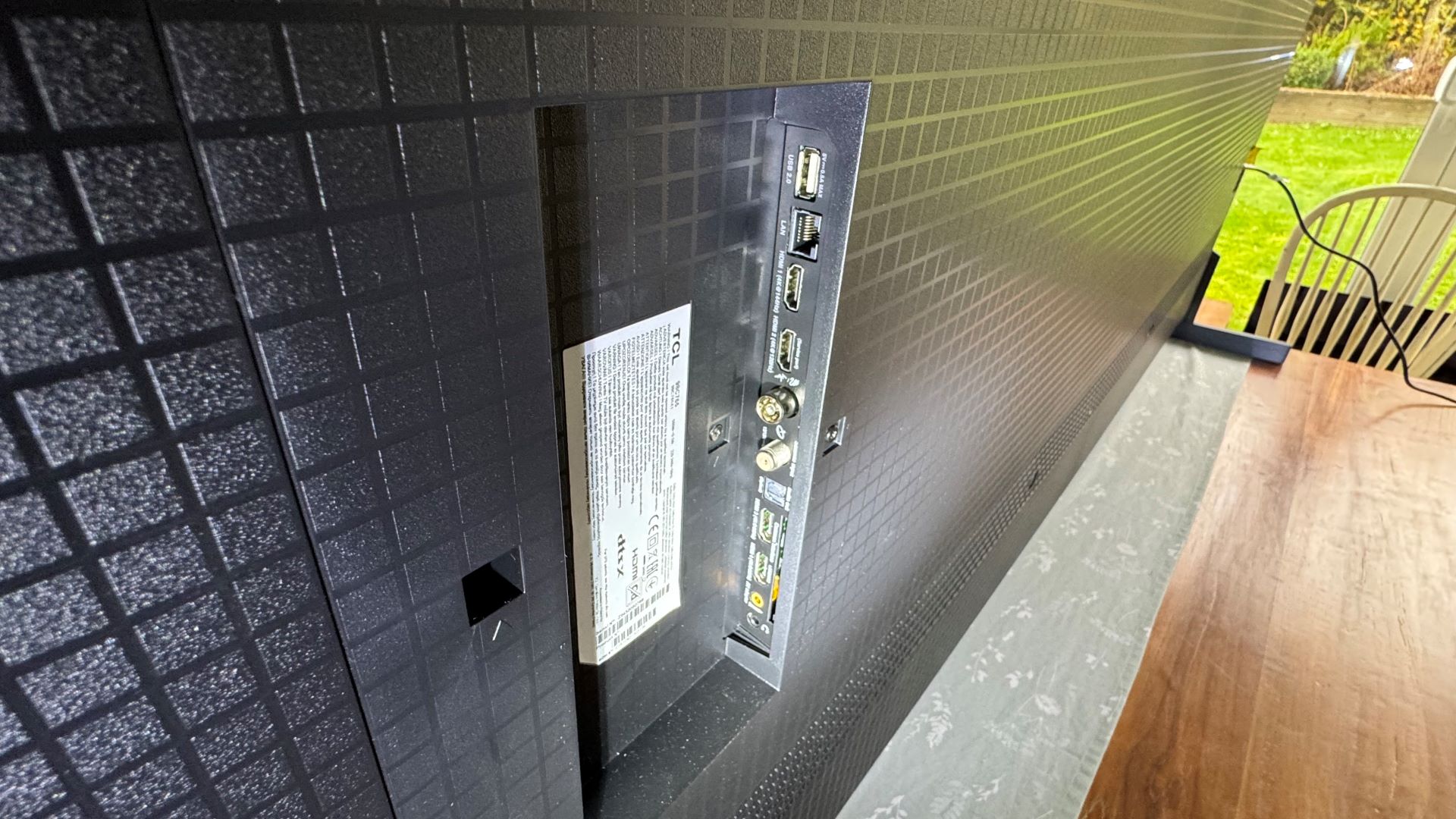
TCL 98Q9BK 98-inch TV review: Features
- 4K FALD VA mini-LED TV
- HDR10, HLG, HDR10+ and Dolby Vision HDR
- Support for the latest 4K gaming features
Some brands might think that just giving you a 98-inch screen for £3,249.99 would be the only features the 98Q9BK needed to bother with, but TCL’s latest TV giant goes much further than that.
Its panel specification, for starters, humbles king-sized TVs costing twice as much. It uses mini-LED backlighting, to deliver more light control and higher brightness. It carries the controls to simultaneously output different levels of light for any given image frame from a massive 1,536 separate zones of these mini-LEDs. It claims to be capable of hitting a huge peak brightness of 2,500 nits, and it uses Quantum Dots to achieve higher volumes than you can get with traditional LCD filter systems.
This mixture of high brightness and wide colour volumes is used to enliven all four of the AV world’s key high dynamic range formats, too: HDR10, HLG, HDR10+ and Dolby Vision. The 98Q9BK even supports the ‘IQ’ version of Dolby Vision that can adjust pictures on the fly to try and retain a consistent HDR feel to Dolby Vision images in varying room lighting conditions. Many rival TVs, including those of such big hitters as Sony, Samsung and LG, only support three of the four main HDR formats, meaning they can’t join the 98Q9BK in claiming to be capable of taking in the best version of every source they’re fed.
The 98Q9BK has received IMAX Enhanced accreditation, too, proving it has been deemed capable of doing justice to content created using IMAX’s proprietary high-quality mastering system.
The 98Q9BK’s connections include a commendable four HDMI ports (with support for most of the latest HDMI 2.1 specification’s features, including refresh rates up to 144Hz), two USBs, an optical digital audio output, a headphone output, and a tuner input plus attendant CI slot. Plus, of course, the 98Q9BK can receive content wirelessly using either Bluetooth or Wi-Fi.
The various elements of the 98Q9BK’s pictures are marshalled by the latest generation of TCL’s AiPQ processing engine. This AI-infused processor works to improve six key picture elements: contrast, clarity, colour, motion, the way HDR tone maps to the screen’s capabilities, and scene detection.
AiPQ’s workings also include bi-directional 16-bit content sensing, enabling the 98Q9BK to deliver a claimed 65,000 levels of backlighting control in real-time from its local dimming engine. The speed of the backlight response should reduce such common local dimming issues as dark shadows, unwanted bright spots and distracting brightness ‘jumps’ when showing sharp cuts between light and dark images.
So-called HVA Pro screen technology, meanwhile – in TCL’s own blind-em-with-science words – “uses nano-level bionic technology to add polyimide to the liquid crystal molecule to form a butterfly wingsuit microstructure which effectively improves the contrast while removing halo and ambient light interference”. In other words, the 98Q9BK claims to offer enhanced contrast by reducing screen reflections and reducing backlight blooming around bright objects.
While the 98Q9BK’s massive pictures are obviously its star attraction, it’s equipped to hopefully go similarly big with its sound, thanks to a 60W, 2.1-channel configuration (including a large subwoofer built into its rear) designed with audio brand Onkyo.
- Features score: 4.5/5
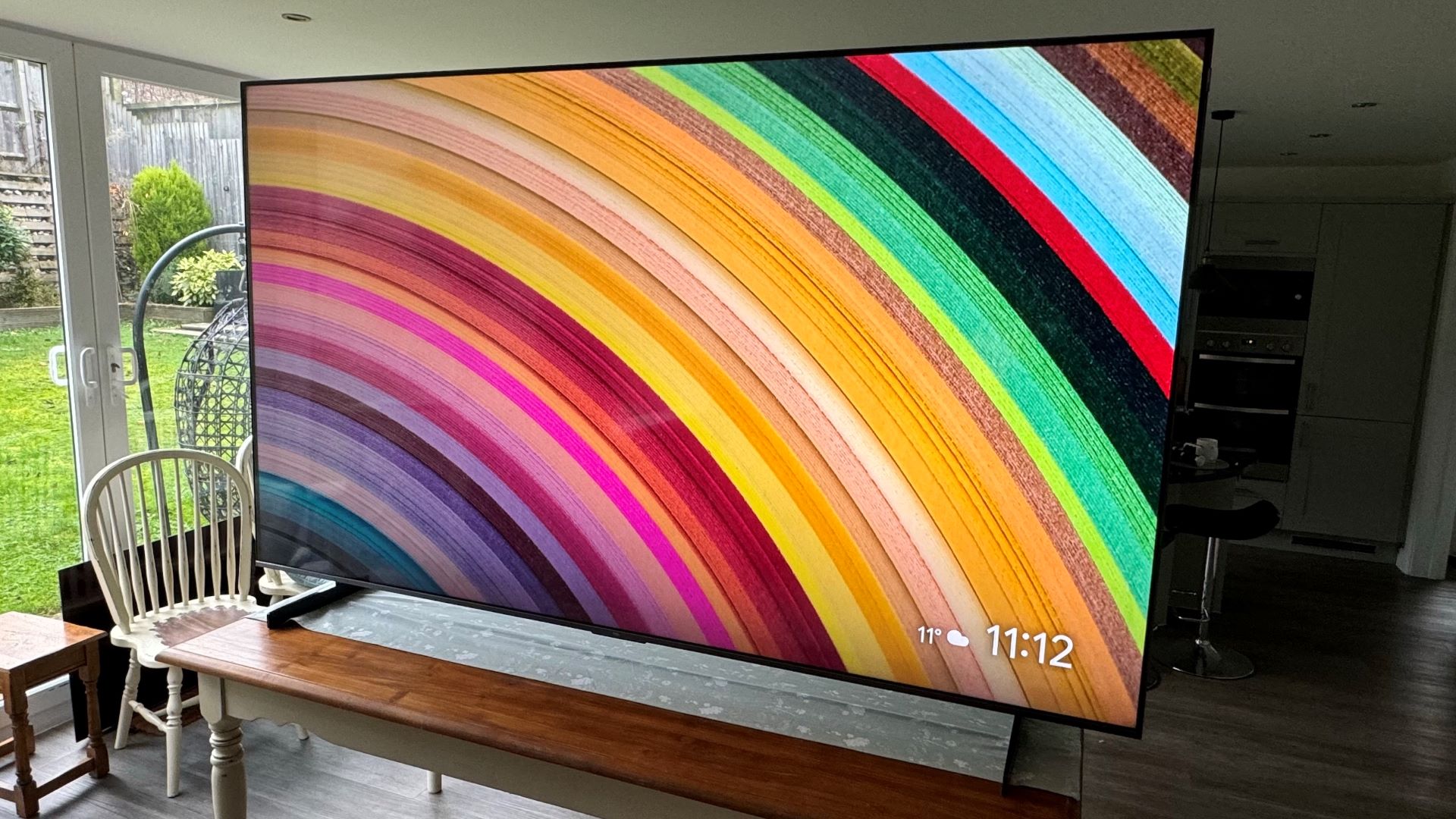
TCL 98Q9BK 98-inch TV review: Picture quality
- Bright, colourful, huge pictures
- Good contrast
- Minor screen clouding
The first thing that hits you about the 98Q9BK’s pictures, of course, is how huge they are. In fact, it’s amazing just how puny even an 85-inch TV looks after you’ve locked eyes with a 98-inch model like this. We are officially well beyond TV territory and firmly into home cinema land here.
Happily, though, the 98Q9BK’s pictures have more than just size going for them. In particular how bright they are, and how impressively that light is controlled and put to use in mostly the right places. On the pure brightness front, while I couldn’t get the 98Q9BK to quite hit the 2,500 peaks that TCL mentions in its specifications for the TV (even on a very small measured white window), it did manage to hit 2,280 nits on a 10% window. This is still a very high number that seems to hit even harder than I’d expect thanks to the sheer scale of the image all this light is emerging from.
The brightness gradually decreases, as you would expect, the more of the screen a bright image fills. But even with a full-screen HDR white test pattern you’re getting well over 600 nits – which again feels pretty much like you’re basking in a bright summer’s afternoon than it usually would when it’s spread across as much screen acreage as the 98Q9BK has to offer.
The 98Q9BK’s brightness is at its most effective, though, when it comes to the extra punch it gives to highlights of HDR content – lamps, glinting glass and metal, Superman’s eye lasers and the like. Such classic HDR fodder looks breathtakingly intense – and even better, this extreme luminosity is achieved without the sort of clipping (lost shading and details) in such peaks that might have been expected from such a relatively affordable TV giant pushing so much brightness.
The 98Q9BK’s Quantum Dot colours, too, earn their corn by retaining rich saturations even in the brightest HDR picture areas. Particularly if you’re watching a Dolby Vision source, where the extra scene-by-scene image data Dolby’s format provides helps the TV unlock an extra nth degree of picture performance you don’t quite get if you’re using its own dynamic tone mapping system on basic HDR10 feeds. There’s enough subtlety in the 98Q9BK’s colour rendering, too, to ensure that the brightness doesn’t cause bright colours to start looking cartoonish or flat (outside of the best-avoided Dynamic preset, anyway).
While it’s its brightness and vibrancy that first catches the eye, you quickly come to appreciate how impressive the 98Q9BK’s black levels are for such a colossal screen. In fact, if the sort of blazing bright highlights I mentioned weren’t able to appear when needed right alongside convincing black colours, they wouldn’t look nearly as intense as they do.

There’s always a worry with TVs – especially really big TVs – boasting large numbers of local dimming zones that very bright objects appearing against dark backdrops will either be accompanied by aggressive amounts of backlight blooming/haloing around them or have to be dimmed down quite heavily to stop such blooming from happening. Neither of these things happened with the 98Q9BK, thankfully, despite how bright the highlights look. Nor does TCL’s TV giant suffer with aggressive light ‘jumps’ if a scene contains hard cuts between dark and light shots, and shadow detailing remains impressively present.
There is a trade-off for the surprising consistency of the 98Q9BK’s brightness and contrast, in that black levels aren’t quite as deep and neutral-looking as those I’ve seen from the most premium mini-LED TVs, such as Samsung’s QN95D range. There’s a hint of greyness and clouding visible in dark and mid-dark sequences, and despite the 98Q9BK having more than 1,500 dimming zones to work with, you can sometimes see faint areas of backlight clouding slipping into the black bars that appear above and below wide aspect ratio films, where they become more noticeable than they tend to be in normal picture areas.
The screen also tends to push brightness a little too aggressively during dark scenes, even in its most accurate Movie mode, so that the screen can sometimes reveal a bit more background detail (and, often, attendant noise) than a source image was mastered to show.
Aside from not being able to keep faint clouding out of the black bars, though, the 98Q9BK’s backlight management mostly feels like a quite sensible balancing choice by TCL’s picture engineers, where they’ve tried to find a compromise between credible black levels and not drawing so much attention to the TV’s backlight controls that you end up feeling like you’re watching those controls doing their thing rather than the film or TV show you’re meant to be watching. There’s potential, perhaps, for TCL to get a bit more extreme contrast out of so many dimming zones in the future, but even as it stands now the results are way more engaging and dynamic than you have much right to see on such an affordable king-sized TV.
As usual with an LCD TV, the 98Q9BK's black levels can drop off a little if you have to watch from much of an angle (vertical as well as horizontal), and if you want to get the TV’s Movie mode tracking to accurate brightness levels with SDR content you basically have to turn the local dimming off – at which point black levels start to become a bit grey.
Other adjustments I’d recommend making to get the best out of the 98Q9BK would start with never using noise reduction on any higher setting than ‘Low’ (and typically turn it off for native 4K). Also, since the combination of the screen’s size and brightness can slightly exaggerate judder with 24fps movies, unless you’re a purist where motion is concerned you could try leaving motion processing on but with the strength of its blur and judder components reduced to their three and four levels respectively. This set-up can leave you with the occasional twitch during camera pans, but there’s no trace of the sort of edge haloing or excessive fluidity side effects associated with more heavy duty motion processing.
One last point to make about the 98Q9BK’s pictures is simply that high-quality sources are your friend. It’s a simple fact of AV life that the bigger a TV’s screen gets, the more it can expose any weaknesses in a source. And when you get to 98 inches, you’ve arguably reached a scale where you can start to see why discussions about 8K are still going on at the periphery of the TV world. The simple reduced pixels per inch factor of pushing 4K to 98 inches means pictures don’t look quite as crisp as they can on a premium 65-inch or 75-inch screen.
Crucially, though, the 98Q9BK’s pictures still look sharp enough to deliver plenty of depth and texture with native 4K sources, as well as a genuine cinematic flourish to go with their epic scale. Plus, impressively considering how affordable it is by super-sized TV standards, the 98Q9BK’s processor does a very respectable job of upscaling HD sources to 4K. At least in the way
- Picture quality score: 4/5
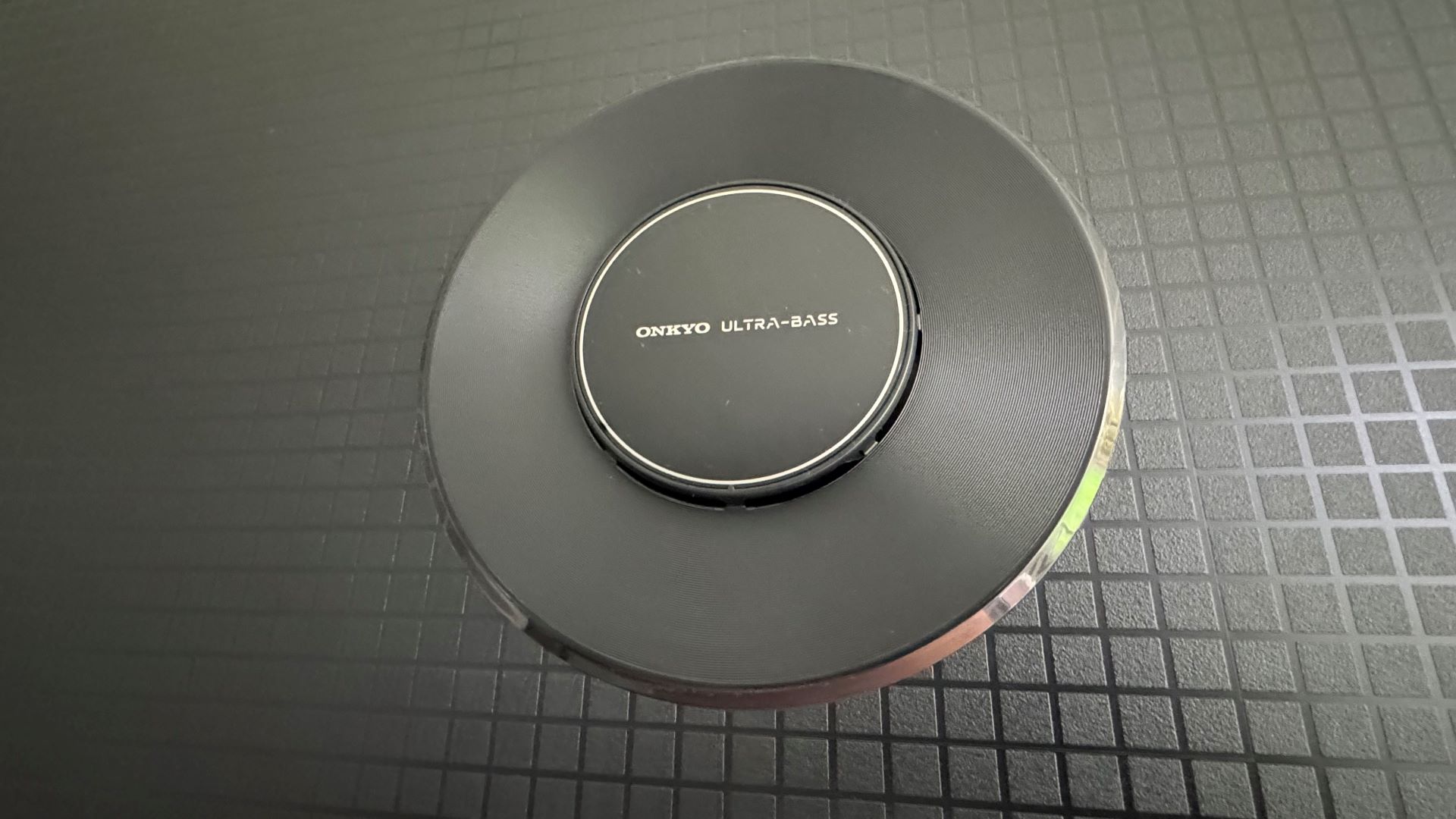
TCL 98Q9BK 98-inch TV review: Sound quality
- Punchy bass
- Accurate sound placement
- Sound confined to screen
Impressively the 98Q9BK manages to produce a sound stage big enough to keep its epic pictures company. In fact, the Onkyo-designed speaker system manages to create a cinematic wall of sound that spreads substantially beyond the TV’s outer edges. There’s nothing coarse or forced about this large-scale sound presentation, either; effects feel cleanly and accurately placed, especially with Dolby Atmos soundtracks, while ambient and scoring soundtrack elements get their own distinct space in the presentation, just as they should.
While the 98Q9BK’s sound exists beyond the edges of its onscreen images – there’s even a mild sense of height to Atmos mixes, in fact – it still manages to make effects that should be emanating from on-screen objects sound as if they’re coming from the screen, not some vague place beyond. The speakers are sensitive enough, too, to pick out plenty of the subtle details and ambient minutiae found in the best film and TV show mixes.
The speakers are powerful enough, too, to deliver a convincing sense of escalation as big action scenes build in intensity, rather than collapsing in on themselves when the going gets tough.
The dedicated subwoofer fleshes out the low-frequency part of film soundtracks reasonably well. Its sound is a little coarse compared with the main speakers, but it doesn’t succumb badly to distortions even under extreme pressure.
There can be a slightly harsh feel to treble sounds during dense soundtrack moments, and dialogue can sometimes sound a little less clear and clean than other soundtrack elements. Overall, though, the 98Q9BK’s sound joins its pictures in being better than expected from such an affordable TV monster.
- Sound quality score: 4/5
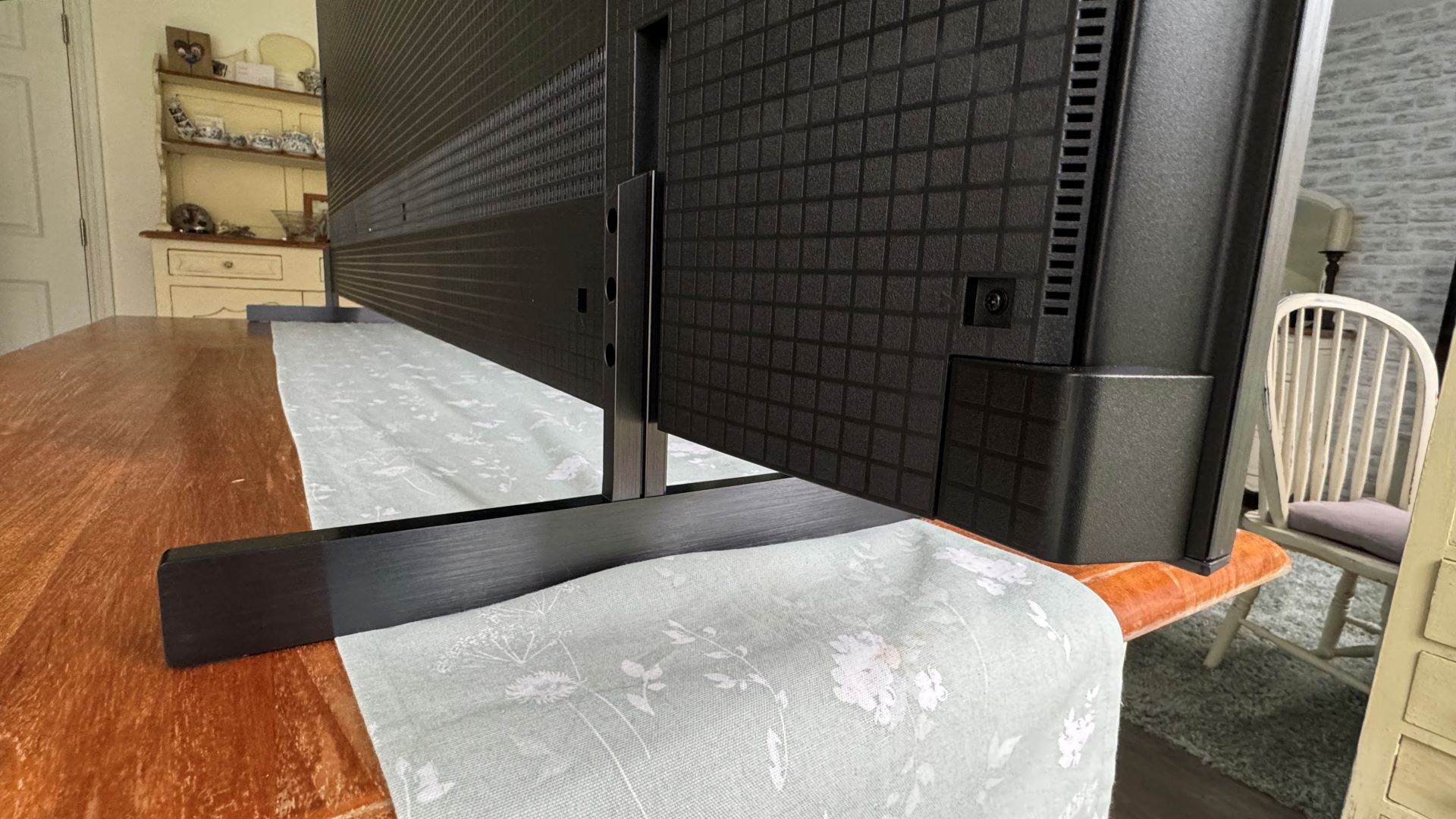
TCL 98Q9BK 98-inch TV review: Design
- Sits on very widespread feet
- Chunky but robust bodywork
- It’s big. Very big.
The only really spectacular thing about the TCL 98Q9BK’s design is how massive its screen is. Everything else about it feels more or less just like a necessarily substantial effort to support that screen as stably as possible.
So its rear is significantly deeper than that of most TVs – and extremely rigid and hefty with it. The frame around the screen actually isn’t as wide as you might expect given what it’s wrapped around, but nor is it in the ‘barely there’ category many premium TVs try to achieve.
If you’re not (bravely) wall-hanging it using its VESA 500x600 rear mounting points, it ships with a pair of long feet that attach quite widely apart to give the screen the stability it needs. Unsurprisingly, you’re going to need a seriously substantial bit of furniture to put your giant TV on.
While long, though, the feet are quite slender when viewed straight on. So while in the end there’s nothing dramatic or sleek about the 98Q9BK’s design, in the end nor is there anything about it that really distracts you from its massive pictures. And that’s kind of all that matters with a home cinema machine like this.
- Design score: 3.5/5
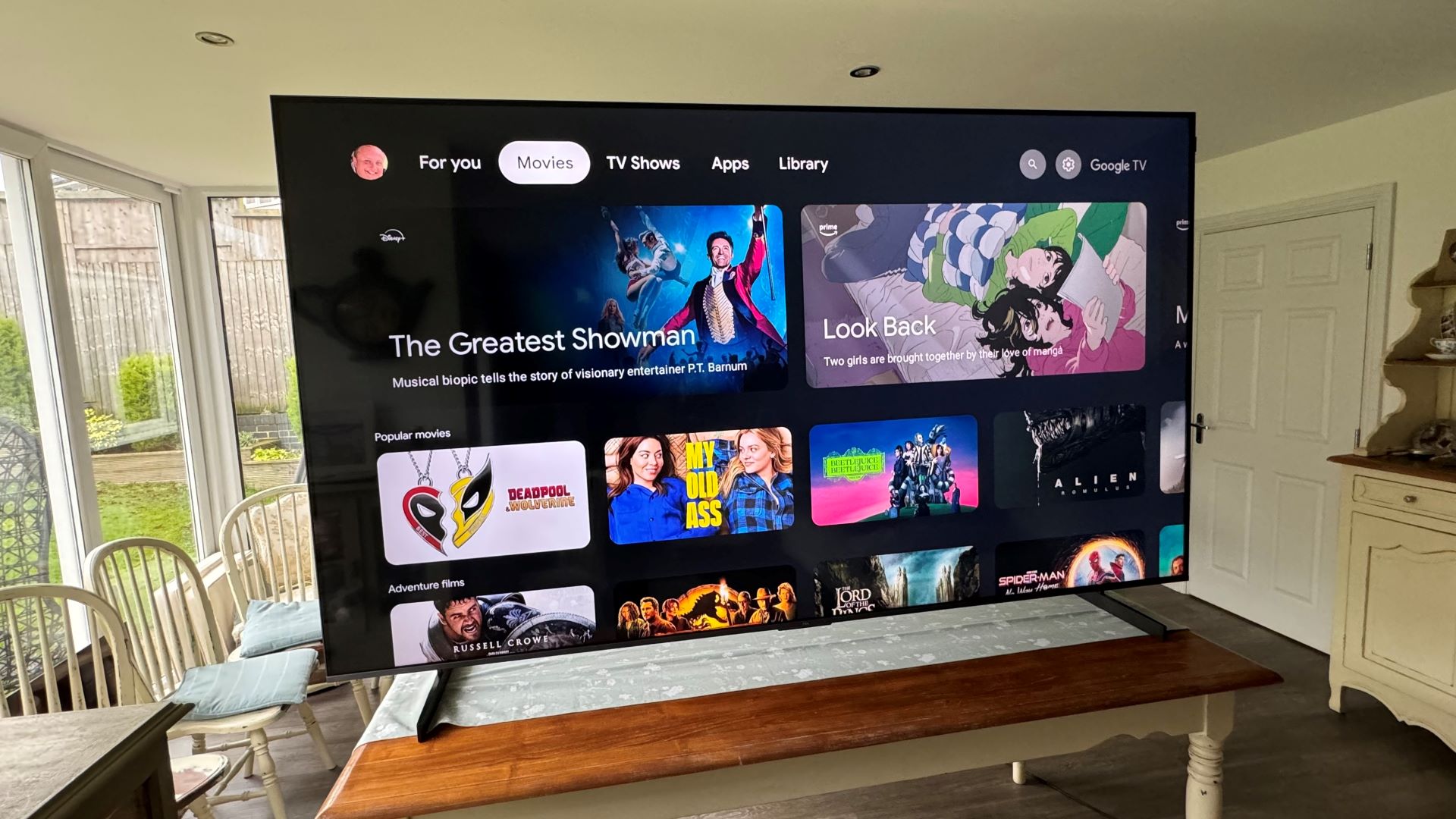
TCL 98Q9BK 98-inch TV review: Smart TV & menus
- Google TV smart system
- AirPlay 2 and Homekit support
- Google Assistant voice control support
The 98Q9BK uses the Google TV smart system. This runs reasonably slickly, and was substantially less buggy during our time with the TV than some previous TCL Google/Android TV systems have been.
Residents of the UK will be very happy, too, to hear that the 98Q9BK already carries the ITVX, Channel 4 and Channel 5 catchup apps despite Google TV’s common hang-ups in these areas. In fact, the BBC iPlayer should also be available by the time you get your set home.
Google’s menus are a bit overwhelming, looking more appropriate to a smart device screen than a TV. Google TV continues not to feel as clever at recommending relevant content as some rival platforms, either, and nor does it support as much customisation as the most user-friendly systems. But you certainly won’t run out of things to watch on it – especially once the BBC Player has joined the mountain of content sources.
The 98Q9BK’s set-up menus are wrapped around the Google TV engine in a pretty typical way, meaning you access them via either a Settings ‘cog’ icon at the top right of the home screen, or a cog button on the remote control. It’s not, for me, a particularly intuitive feature menu system; it always feels as if it’s just been ‘stuffed in’ around the edges of the Google core. But it doesn’t take too long to learn your way around, in truth. And at least the remote control carries a decent selection of direct app access buttons to reduce the time you need to spend in the TV’s menus.
- Smart TV & menus score: 4/5
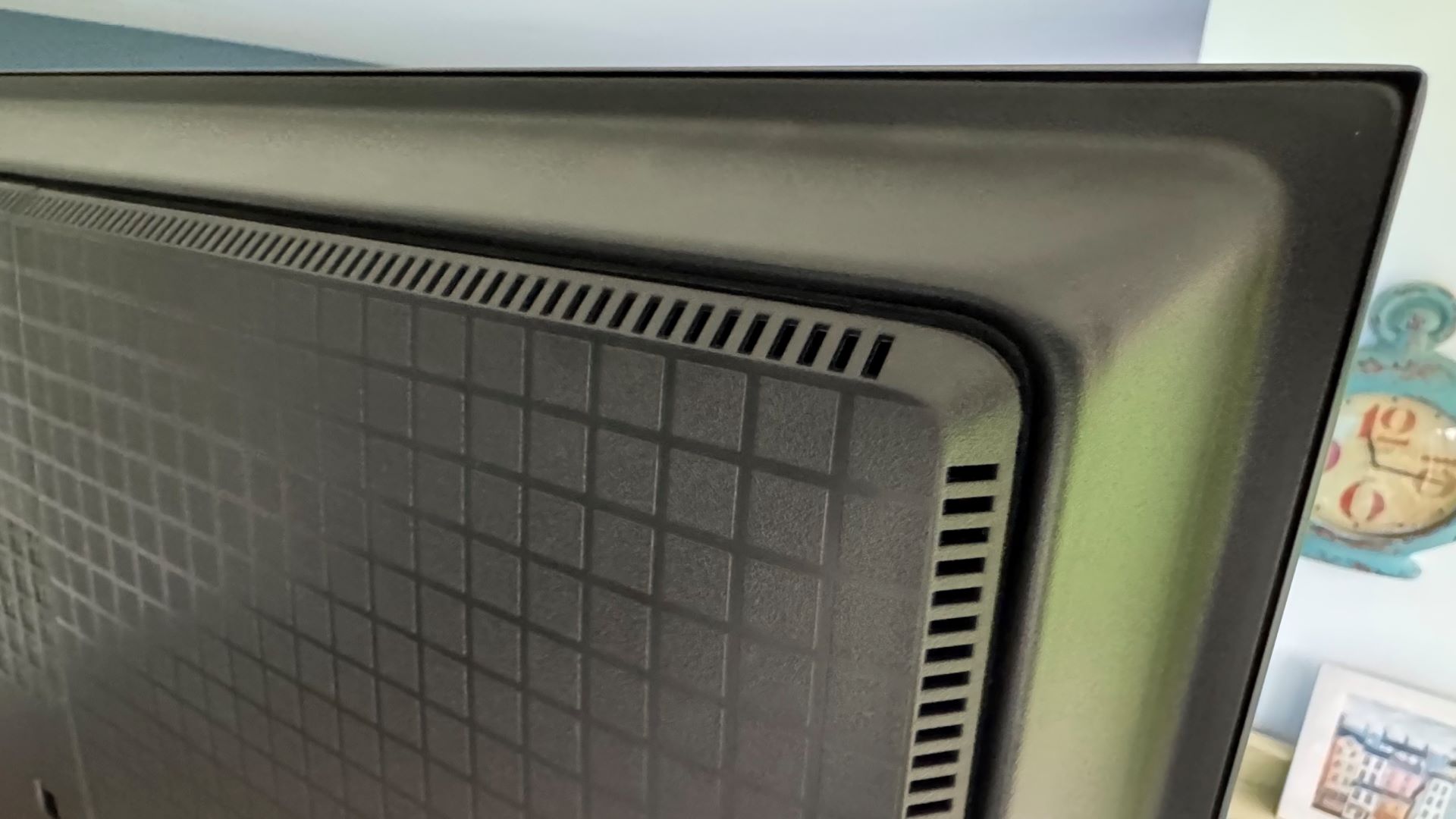
TCL 98Q9BK 98-inch TV review: Gaming
- 4K 120Hz, 144Hz and VRR support
- Special game-focused option screen
- Input lag of 13.4ms at its lowest
There are two distinct sides to the TCL 98Q9BK’s performance as a gaming display. On the plus side, it’s almost absurdly awesome to be able to play relatively adventurey, explorationy, RPGey games on such a massive, bright, colourful and crisp screen. Especially as the 98Q9BK is able to support both variable and high frame rates, meaning that if a game’s up to it, you don’t have to worry about any judder or screen tearing disturbing the immersive effect of gaming on such an epic scale. The 98Q9BK’s Game preset also gets the time the screen takes to render incoming images down to a very respectable 13.4ms, meaning that your connection with game worlds is as responsive as it is huge.
There’s a reason, though, that the most competitive gamers typically use far more compact gaming monitors. Namely that they can take in the whole picture in a single glance. With the 98Q9BK, though, unless you’re sat absolutely miles away from it you’ll have to move your eyes around the image to take every detail in – wasting precious milliseconds that could cost you a life or two. But this is absolutely not the 98Q9BK’s fault, of course; it’s just a simple matter of science.
A fairer complaint about the 98Q9BK’s gaming performance is that it looks like it reduces the level that its local dimming system is operating at in Game mode to deliver the screen’s fast response times, leaving dark game areas looking a bit greyer than dark video scenes tend to. But this feels like a pretty small price to pay for everything else the 98Q9BK’s huge, bright and colourful images can do for your gaming experience.
- Gaming score: 4/5
TCL 98Q9BK 98-inch TV review: Value
- Cheaper than some 65-inch TVs!
- Offers a high feature count for its price
- Relatively big price step up from the 85-inch
As I’ve hopefully proved by now, the 98Q9BK is extremely well-specified for its money. You don’t just get a 98-inch screen for £3,250; you get a fearsomely bright 98-inch screen powered by mini- LED backlighting, more than 1500 local dimming zones, Quantum Dot colours, and connections capable of handling all the latest cutting-edge gaming features and all four main HDR formats. It gets plenty of performance out of all these features, too, hitting a level that would previously have been unthinkable on such a huge screen without spending substantially.
The only wrinkle on the value front is that the step-down 85-inch 85Q9BK only costs £1,899. That’s a saving of more than £1,300 for the loss of 13 inches of screen. In truth that extra 13 inches of the 98Q9BK does make a bigger real-world cinematic difference to your viewing experience than it sounds on paper. Though at the same time, £1,300 adds up to a whole lot of 4K Blu-ray discs…
- Value score: 4.5/5

Should I buy the TCL 98Q9BK 98-inch TV?
Buy it if...
Don't buy it if…
Also consider
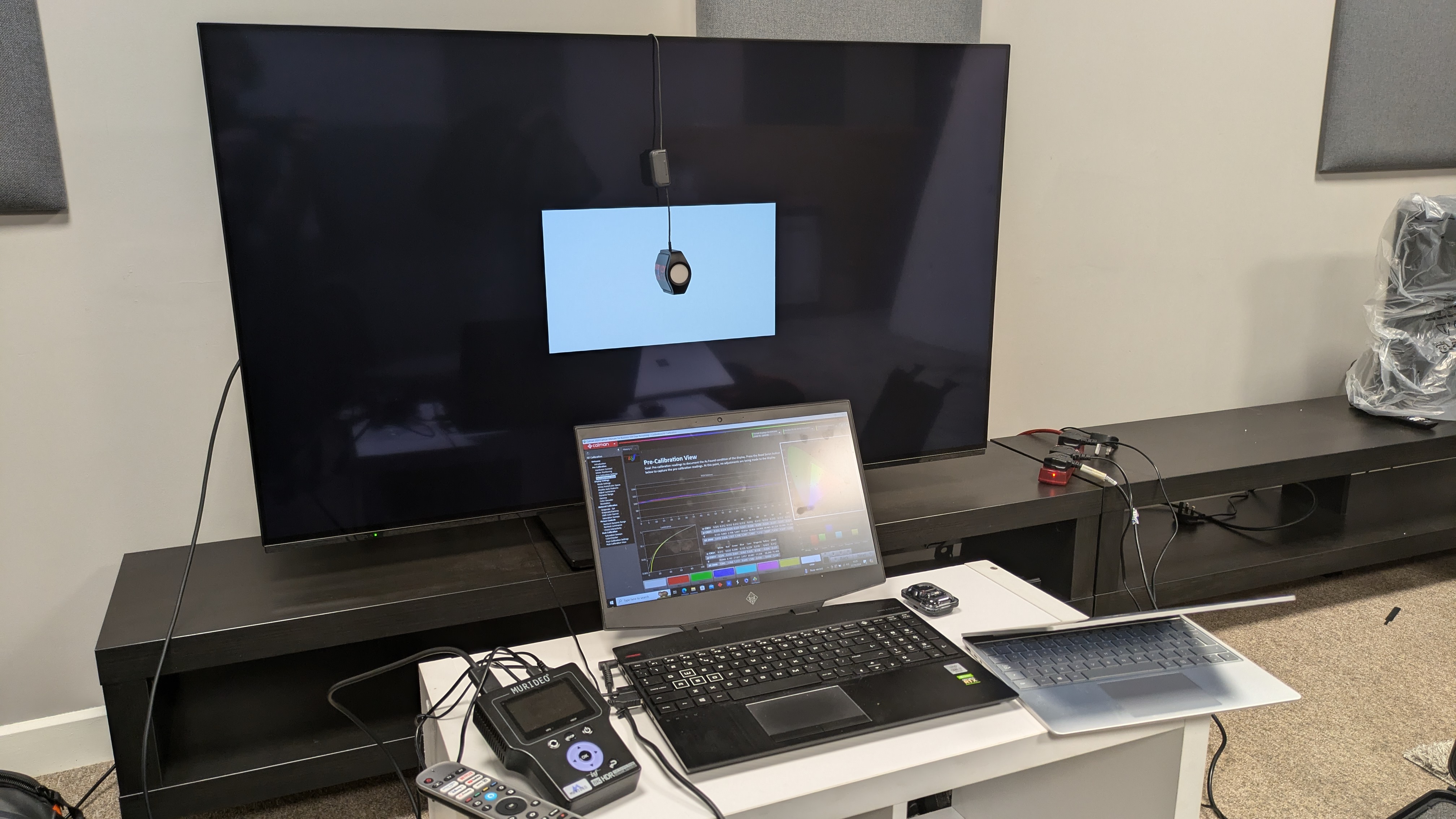
How I tested the TCL 98Q9BK 98-inch TV
- Tested over 14 days
- Tested with 4K Blu-rays, multiple streaming platforms and resolutions, Freeview HD broadcasts, and HD Blu-rays
- Reviewed in both dark and light dedicated test room conditions, on its feet in both corner and flat wall positions
The size of the 98Q9BK’s screen leaves no hiding places for flaws in either your sources or the screen’s performance. So I started out testing with a mixture of 4K, HD and even SD content focusing on how well the screen coped with all of these very different – and all widely available – quality sources.
While doing this I also experimented with some of the screen’s most important picture adjustment settings – noise reduction, motion processing, local dimming, dynamic contrast and various presets - to get the best out of the TV with each source type.
Content focused on in particular included 4K TV show streams from Netflix and Amazon Prime Video (including Goliath, Bosch, The Lincoln Lawyer and Lost In Space), and both 4K and HD Blu-rays of Alien: Romulus, Blade Runner 2049 and Top Gun: Maverick.
As well as extensive subjective testing in light and dark room settings, I measured the screen’s brightness, grayscale tracking and colour accuracy for both SDR and HDR content using Portrait Displays' Calman calibration software, G1 signal generator and new C6 HDR5000 light meter.
Gaming, finally, was tested using a mixture of exploration (including Assassin’s Creed: Valhalla and Baldur’s Gate 3) and FPS (Call Of Duty Black Ops 6 and Apex Legends) titles on both the PS5 and Xbox Series X.
First tested: December 2024







